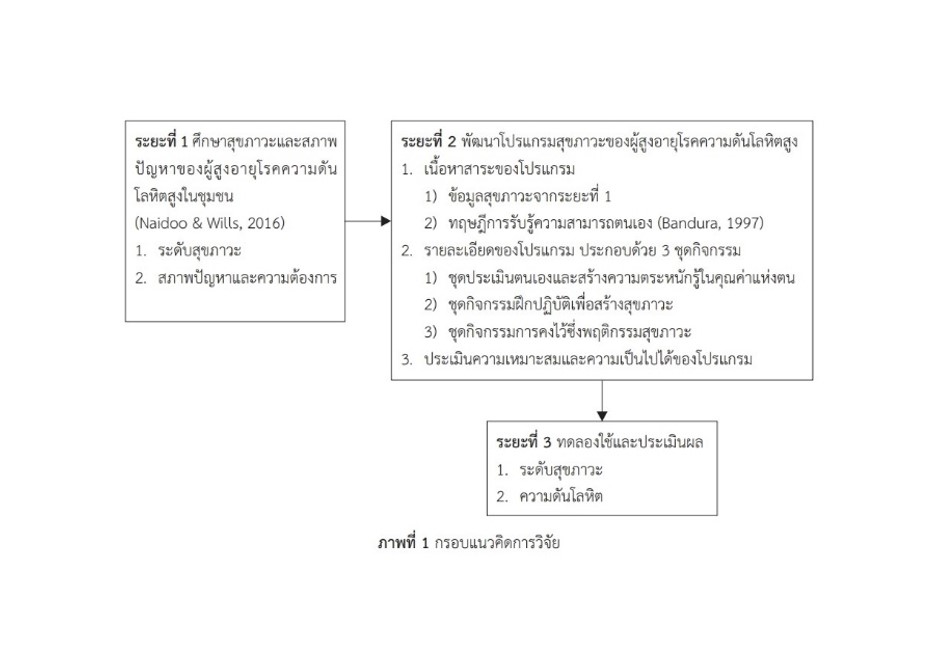การพัฒนาโปรแกรมสุขภาวะของผู้สูงอายุโรคความดันโลหิตสูง ตำบลปราสาท อำเภอบ้านด่าน จังหวัดบุรีรัมย์
คำสำคัญ:
การพัฒนาโปรแกรม, สุขภาวะ, ผู้สูงอายุ, ประวัติโรคความดันโลหิตสูงในครอบครัวบทคัดย่อ
การวิจัยและพัฒนานี้มีวัตถุประสงค์เพื่อพัฒนาและศึกษาผลของโปรแกรมสุขภาวะของผู้สูงอายุโรคความดันโลหิตสูง ตำบลปราสาท อำเภอบ้านด่าน จังหวัดบุรีรัมย์ ดำเนินการวิจัยเป็น 3 ระยะ ได้แก่ ระยะที่ 1 ศึกษาสุขภาวะและสภาพปัญหา กลุ่มตัวอย่างเป็นผู้สูงอายุโรคความดันโลหิตสูง 175 คน และตัวแทนชุมชน 5 คน ระยะที่ 2 พัฒนาโปรแกรมสุขภาวะ โดยประยุกต์ใช้ทฤษฎีการรับรู้ความสามารถตนเองของ Bandura (1997) ประเมินความเหมาะสมและความเป็นไปได้ของโปรแกรมโดยผู้ทรงคุณวุฒิ 5 คน ระยะที่ 3 การทดลองใช้และประเมินผล กลุ่มตัวอย่างเป็นผู้สูงอายุโรคความดันโลหิตสูงกลุ่มทดลองและกลุ่มควบคุม กลุ่มละ 37 คน เครื่องมือวิจัยประกอบด้วย แบบสอบถามสุขภาวะ แบบสัมภาษณ์เชิงลึก แบบบันทึกสุขภาพ ดำเนินการวิจัยในช่วงเดือน มีนาคม ถึงเดือนตุลาคม พ.ศ. 2565 วิเคราะห์ข้อมูลด้วยสถิติพรรณนา วิเคราะห์เชิงเนื้อหา และสถิติที
ผลการวิจัย พบว่า 1) โปรแกรมสุขภาวะผู้สูงอายุโรคความดันโลหิตสูง ประกอบด้วย ชุดกิจกรรมประเมินตนเองและสร้างความตระหนักรู้ในคุณค่าแห่งตน ชุดกิจกรรมฝึกปฏิบัติเพื่อสร้างสุขภาวะ และชุดกิจกรรมคงไว้ซึ่งพฤติกรรมสุขภาวะ 2) ภายหลังเข้าร่วมโปรแกรม กลุ่มทดลองมีระดับสุขภาวะโดยรวมเฉลี่ย (x̅ = 4.51, SD = 0.34) สูงกว่ากลุ่มควบคุม (x̅ = 4.05, SD = 0.47) อย่างมีนัยสำคัญทางสถิติที่ระดับ .05 (t=-4.719, p < .001) และมีค่าเฉลี่ยความดันซีสโตลิคลดลงกว่าก่อนเข้าร่วมโปรแกรม (t=4.262, p < .001) ค่าความดันไดแอสโตลิคลดลงกว่าก่อนเข้าร่วมโปรแกรม (t=6.169, p < .001) อย่างมีนัยสำคัญทางสถิติที่ระดับ .05 แต่เมื่อเปรียบเทียบค่าเฉลี่ยความดันโลหิตระหว่างกลุ่มทดลองกับกลุ่มควบคุม พบว่าค่าเฉลี่ยของความดันโลหิตไม่แตกต่างกันอย่างมีนัยสำคัญทางสถิติ
จากผลการวิจัยครั้งนี้มีข้อเสนอแนะว่า พยาบาลและบุคลากรสาธารณสุขสามารถนำโปรแกรมสุขภาวะ ไปประยุกต์ใช้ในการจัดกิจกรรมเพื่อส่งเสริสุขภาวะของผู้สูงอายุโรคความดันโลหิตสูง และโรคไม่ติดต่อเรื้อรังอื่น ๆ ต่อไป
เอกสารอ้างอิง
Alencar, L., & Sardinha, A. (2019). Hypertensive elderly people: Assessing the quality of life. Acta Scientiarum Health Sciences, 41, e44652.
Bandura, A. (1997). Self-efficacy: The exercise of control. W H Freeman: Henry Holt & Co.
Chantakeeree, Ch., Sormunenc, M., Jullamateb, P., & Turunena, H. (2022). Understanding perspectives on health-promoting behaviours among older adults with hypertension. International Journal of Qualitative Studies on Health and Well-being, 17(2103943). Retrieved from https://doi.org/10.1080/17482631.2022.210394
Division of Non Communicable Diseases, Ministry of Public Health. (2022). NCD annual report 2564. Retrieved from https://online.fliphtml5.com/bcbgj/flap/#p=1
Department of Health. (2021). Bureau of elderly health annual report 2021. Retrieved from https://eh.anamai.moph.go.th/th/anniversary-report
Jing, X., Fan, Y., Lei, S., & Dongfu, Q. (2020). Do integrated health care interventions improve well‑being among older adults with hypertension? Evidence from rural China. Social Indicators Research, 160(1), 825-843.
Kim, A., Jang, M., Park, K., & Min, J. (2020). Effects of self-efficacy depression and anger on health-promoting behaviors of Korean elderly women with hypertension. International Journal Environmental Research and Public Health, 17(6296), 1-14. Retrieved from https://www.ncbi.nlm.nih.gov/pmc/articles/PMC7504112/
Krejcie, R. V., & Morgan, D. W. (1970). Determining sample sizes for research activities. Educational and Psychological Measurement, 30, 607-610.
Naidoo, J., & Wills, J. (2016). Foundations for health promotion (4thed.). London: Elsevier.
Nakkling, Y., & Tudsri, P. (2017). Effect of self–efficacy enhancement program on health behaviors among older adults with uncontrolled hypertension. Apheit Journal, 6(1), 27-35. [In Thai]
Nunyapruk, Ch., Therawiwat, M., Kaeodumkoeng, K., & Imamee, N. (2019). Factors related to blood pressure control behaviors among hypertensive patients in Ranod hospital. Songkhla province. Journal of Health Education, 42(1), 190-203. [In Thai]
Prasart Health Promoting Hospital. (2021). Statistics of elderly patients with hypertension in responsible areas Prasart health promoting hospital, fiscal year 2022. Babgkok: Prasart Health Promoting Hospital. [In Thai]
Rojpaisarnkit, K., & Rodjarkpai, Y. (2018). Well-being of the elderly living in urban and rural areas of Thailand. The Public Health Journal of Burapha University, 13(1), 113-125. [In Thai]
Srisa-ad, B. (2012). The principle of research (7th ed.) Bangkok: Suveeriyasarn. [In Thai]
Sukadisai, P., Malapoot, Ch., & Kittiyanusan, R. (2015). Life style and guidelines for well-being of the elderly in the eastern region. Journal of Education and Social Development, 10(1), 90-102. [In Thai]
Supasri, S., Wungrath, J., & Boonchieng, W. (2021). Effects of a health promotion program on perceived self-efficacy and outcome expectations on self-care among elderly with hypertension, Chiang rai province, Thailand. Thai Journal of Public Health, 51(1), 33-42. [In Thai]
Songwatthanayuth, P., & Sirikunwiwat, J. (2019). Storyline for health promoting in persons with hypertension. Journal of The Royal Thai Army Nurses, 20(3), 72-78. [In Thai]
Sukolpuk, M., Thanirat, S., Radabutr, M., Dechpoonyachit, P., & Muntraporn, A. (2018). Health promotion strategies to prevent and control high blood pressure. Journal of The Royal Thai Army Nurses, 19(3), 54–61. [In Thai]
Thamma-Aphiphol, K., Soonthorndhada, K., Pornsiripongse, S., Wirojratana, V., Winichagoon, P., Srisupan, W., & Srivanichakorn, S. (2014). Participatory action research on the holistic care model for the elderly. Journal of Health Systems Research, 8(2), 120-131. [In Thai]
Thaprawat, S., Apinundecha, Ch., & Limtoprasert, S. (2021). The effectiveness of self- efficacy enhancement program on health behaviors of elderly hypertensive patients. UMT Poly Journal, 18(2), 290-303. [In Thai]
Thongsuk, W., Tipwareerom, W., & Supametaporn, P. (2020). Effects of empowerment program on health behaviors, body mass index and blood pressure levels in patients with uncontrolled hypertension. Nursing Journal, 47(4), 229-241. [In Thai]
Tudsri, P., & Nakkling, Y. (2018). Health promotion behaviors of persons with hypertension: Comparison between controlled and uncontrolled blood pressure. Thai Journal of Cardio-Thoracic Nursing, 29(2), 157-169. [In Thai]
Wolwat, K., Suwan, P., & Chanmolee, Ch. (2019). Development of the community elderly care model for hypertension, Wangwiset district, Trang. EAU Herritage Journal Science and Technology, 13(1), 210–221.
Yang, S., Kim, S., & Lee, S. (2016). Effect of a South Korean community-based cardiovascular disease prevention program for low-income elderly with hypertension. Journal of Community Health Nursing, 33(3), 154-167.

ดาวน์โหลด
เผยแพร่แล้ว
รูปแบบการอ้างอิง
ฉบับ
ประเภทบทความ
สัญญาอนุญาต

อนุญาตภายใต้เงื่อนไข Creative Commons Attribution-NonCommercial-NoDerivatives 4.0 International License.




